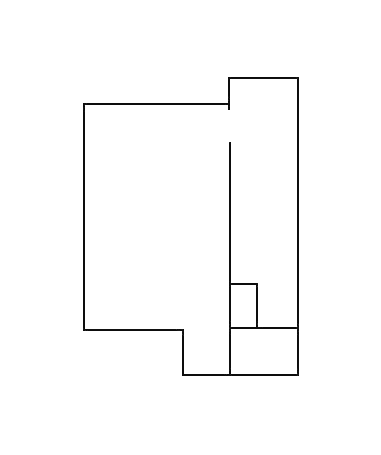An essay and conversation between Gretchen Frances Bennett and Laura Sullivan Cassidy
Pure and whole, tough and tender. Home. Alive.

I first met Laura Sullivan Cassidy on a rainy night, sheltering in the doorway of the El Capitan building, home to the Seattle art venue, Vignettes. Our conversation, I believe, started with the weather. We were there to see Mel Carter’s “When the Caustic Cools,” projected on a building across the street, and we talked about the rain letting up.
We met next on another wet night, when Vignettes Marquee presented Laura’s work, “What Feels Most True: A Dream Hypnosis for Radical Awakeness,” a two-channel projection of “found and collected family slides and digital images,” accompanied by a dreamy abstract audio track by Laura’s husband, Erin Sullivan. For this one–night–only presentation in a storefront in Seattle’s Capitol Hill neighborhood, images cycled in slide show cadence, sometimes superimposed with san-serif text: “Three / Two / One / Before you can begin you must open your eyes / See the tattooed tear drops / See the watcher watching / See the knower not knowing a thing / Now, with your left hand, smooth the wrinkle that will not iron out / And with your right hand: feel / Can you feel warmth in what you’ve forgotten? / Can you feel pretty when you fall? / Then, say that we will find a way to reach each other / Say that you did not dream of airplanes falling from the sky last night / Say that you have not been having that dream for as long as you can remember / Say that you know nothing / Say that you have nothing / Say that you want to give it all away / Because what could feel more real? / What could be more true? / All sickness is homesickness / All hypnosis is self-hypnosis.”
Laura describes this work as being “somewhere between performance and persuasion… images like strobe lights and words like wands are meant to rearrange natives, immigrants, and passersby alike. The quasi-narrative, two-channel, glass-enclosed slideshow will reimagine the villagers; remember them, forget them, and return them…back to where they were when they started so long ago: Pure and whole, tough and tender. Home. Alive.” A promotional image for “What Feels Most True” is titled simply “Found Family Image, Kodachrome Slide.” This image, depicting kids floating on deep blue water under a slightly less deep blue sky, is both strange and known, like most photographs in this work. We see weedy gravel in front of white industrial garage doors, a hand feeding a bird, sea life, twin moveable jet bridges leading to no airplanes, side by side statues with caution tape necklaces, all brined souvenirs of absent animals, plants, dirt, watery nights, and stars.
We met next at her house, and talked about being ourselves, being tied to the weather, how we weren’t sleeping, and about our fathers, both scientists who passed away and left us image collections. We ate kale and listened to Henry Flint’s Raga Electric on vinyl. Later, Laura sent phone photos of her father, Paul M. Cassidy’s dive journals, pulling out phrases, like “Nothing really unusual,” and “Much too turbid.” “There were specific crabs my dad was studying in the Philippines. He told me he found a species no one knew about, he tacked the name ‘Paul’son’ there on the end, you can see it on the cover (of a dive journal)”. “I’ve understood much more about my need to notate and document, since going through his things. What a diarist!”
As I get to know her, I take any occasion to talk with Laura Sullivan Cassidy: in person, in weather, by text, or, in this case, by email.


Gretchen Bennett: I saw an electric window sign in the International District, signaling both open and closed, when unlit. I thought of it, with your work. Do you look at the family slides as both open and closed spaces, and do they provide clues to your past and to your father; and, something that stops and can’t fully show itself?
Laura Sullivan Cassidy: Absolutely. I probably wouldn’t have used those words—open and closed—but they’re perfect.
After my dad retired he took ownership of all the family photos and slides, and scanned them in. He gave us all copies, and I’ve always loved family photos so I’ve always had them at the ready and I’ve periodically gone down rabbit holes with them, but I really and truly binged on them after he passed away. When I go into the folders now (he separated them via era: ’60s, ’80s, etc.), it’s as if the lights are on and the door is open but no one’s home. I can get in and look around, but there’s really no one who can answer my questions or show me around.
So yes, open and closed.
GB: I have a collection of Kodachrome slides from my father. When I rediscovered them, I had less a memory of the imagery, and more a memory of him taking them. Are images from our lives something we want, but we may need to forget about for a while?
LSC: That feels right. I somehow want it to be more right with the old Kodachrome stuff, but it may be most true with our iPhones. Most of us do this capture, capture, capture thing, and I suspect we really don’t even know why we’re documenting the sunset shadows or the dinner party or the art show or the cat sleeping. It’s reflexive at this point, but it can prove useful, too. How often do we say, “Oh I forgot all about this picture!” when scrolling through our handheld archives? My mind tends to be really busy all the time and I’m always mentally juggling, so I am forever finding things I have forgotten about. Images, notebook pages, groceries even!
Maybe we don’t need a cure from/for them, but gaps, keeping us separate from them, are good? So, when we realize (again?) that they are, it’s like more life?
I feel myself trying to name what that pay-off is. Are they more like life, is that what the reward is? I think for me, because my memory is sort of foggy and spotty, the reward is the opportunity to piece it all back together. The opportunity to tell or retell a story.
Some images provoke a visceral response and you’re back in that moment instantly, but some are more slippery than that, and that’s okay with me. I kind of like not knowing. I kind of like the soft, vague tether—and I’m really grateful for that. My memory has been weird ever since this medical event I went through a few years ago, and I wouldn’t have predicted that I’d be okay with the fog, but I really am. Images do sometimes clear things up, but for every image that offers clarity, there’s another that is impossible to place, name, tag, number, or hold on to.

GB: “The quasi-narrative, two-channel, glass-enclosed slideshow will reimagine the villagers; remember them, forget them, and return them…back to where they were when they started so long ago.” It seems that they are returned to a new home each time, given the looping course of the images, I find that exciting. “And I’ll be there with them—making those return/transformations, too.”
Isn’t this a way of moving forward, saying both hello and good-bye, letting go pieces at a time, as if through “strobe lights?” Not to forget, exactly, but to remember, like talking and listening at the same time, so that every moment is a living moment, and this living is not separate from the imagery, but on it, like dust and fingerprints.
LSC: Absolutely, the goal really was to create a bit of a mind-scramble. I truly meant it as a hypnosis or a meditation; a way to wipe the screen and get rid of some negativity and replace it with some wonderment and remembrances and curiosity.
GB: Are these found photographs also remembering and forgetting in front of us?
LSC: I seem to want to hang on to them as not quite fiction and not quite non-fiction, so I suppose they are remembering and misremembering.
It’s like how we all have different memories of any one event, right? Especially because film (as opposed to digital) forces and allows us to capture and retain a lot of imperfect, in-between moments, I feel like what the old pictures do is lob little moments at us and those moments aren’t true or untrue. They aren’t giving us back that day in 1979 and they aren’t taking it away. Like an argument in the matriarch’s living room about which uncle owned the white Pontiac station wagon, they are saying, “Hey look, the past isn’t something you can hold on to.”
And I guess I want that to also be a reminder that you can’t hold on to the present or the future either. None of this is completely knowable. Not all of this is nameable. Ten people in any given room, on any given street corner, see ten different things. Is it weird that I find that comforting?
GB: Not weird, at all. I see your work as elemental — the everyday we all know. But I also think the work is biased towards your particular sensibilities. Not only with “What Feels Most True,” but I’m thinking now of a line from Mountain Lakes, from your recent book Backyard Birds Barking at Planes: “Never has our greed been so pure and so right. Never has it been so difficult to leave a place, never has it felt this cruel.” When I read this, I can see the lake the whole time. Everyone can easily reference their own version of a lake, and its transformative qualities.
From The Phone Call, also from Backyard Birds, is the limpid sentence, “Before all of this and any of you.” Here, I see a part of a life lived, a pause, and more life will be lived, in some sequence, like a slideshow.

LSC: I love that my stories can feel like a slideshow, and yes, what moves me the most are the incidental days when being human is kind of frozen in ice for minutes at a time, and then—poof—it thaws again.
I think where I have found my own place in writing, both fiction writing and in journalism, is in those particulars. I do take in a great deal. Retaining it? Depends whether I write it down or not. But I take in a great deal. I see a lot of what’s happening in shadowy corners and I hear things in pauses and stops and starts. I am not saying that those things are absolute truths, but what I pick up often really resonates. I have experience and confidence enough to admit that. I notice things, and I’m proud of that. And grateful for it.
GB: “What Feels Most True” seems to be as engaged with literature and performance, as it is with art. Do you relate to your work as a visual artist, more, or as a writer, and does this matter, for the work?
LSC: I have always identified very, very strongly and clearly as a writer but for the past ten years or so I’ve been very driven to do anything other than hand you a page of words and ask you to read it. While I’m certainly very interested in publishing, I’m equally interested in finding new and different ways to tell you a story.
In many ways, my roots are in music, so I have this weird and persistent metaphor about putting out a record or setting up a show at a club. I want to be able to do the equivalent of that within the literary realm. I think once I came to really good terms with the fact that my short stories are indeed really quite short, and that my fiction is more kinda-true than not-true, I felt even more motivated to do, well, to do weird stuff with my work. To do ‘other’ stuff with it.
I do a lot of visual stuff too, though. It’s true. I also really like collaborating with visual artists. I like illustrating my stories and I’m not sure I’ve ever put any of them out in the world without some kind of visual accompaniment.
GB: For me, “What Feels Most True” relates to Jonas Mekas’ documentary film As I was Moving Ahead, Occasionally I saw Brief Glimpses of Beauty, and how he compiled his home movies into a film, in the order the rolls came off the shelf, saying, “I have never been able, really, to figure out where my life begins, and where it ends.” Is this how you work?
LSC: Actually, I think I’m a writer because I’m trying to understand life. I don’t think it’s definitively possible, but I want to try. I want to put some of it down in a certain way that feels true enough. Like, I can accept this rendering of what happened, or what could have happened. Or what happened through this one particular lens. I am highly, highly motivated to understand things, but in a perhaps confusing way, I don’t have a death-grip on that understanding. It just feels good for a little while to feel like I have some resonating ideas about why and how.
But like all art and literature, once I pass the thing to you, you get to decide how you understand it. It’s a cool contrast with my life as a journalist. In that role, I want you to know for sure what I’m trying to tell you. But when I’m writing freely from the world around me, separate from work, I want to just decode this little thing I saw or felt or heard or did, and then I want you to hold on to it for a little while and decode it too. It’s a telephone game.
GB: Because you are not always the person who took the photographs, is meaning up for grabs; do you become free to assign meaning, based on what you know of the photographer, who is, in many cases, your father?
LSC: As far as I know, my dad took all the vintage images. There were some current/contemporary digital images in there as well, and those came what was dumped into laptop folders from a couple of digital cameras that Erin and I have shared over the years.
But in terms of the old images, the meaning is so up for grabs. Again, it’s a telephone game. That image of people riding flour sacks down the wavy yellow slide, god, I really have no idea. I think it’s out by the ocean somewhere. Like, we probably rode go carts immediately before or after.
What did my dad think he was remembering with that shutter button? I have no idea. Maybe he took the picture out of obligation or as a distraction; maybe he was thinking about work or his sore back or what he didn’t get to do as a poor Irish catholic kid in Tacoma.
But when I take that photo and layer some ideas on it, and give it to you, that one moment in my dad’s life is alive again. Ideally at least, it’s reactivated and it can do new and different things with whatever you layer onto it.
I wanted to take some of those old moments, and some less old moments, and put them back into the world—together with the reminder that we can trust ourselves and we can love ourselves and we can be ourselves. We HAVE to trust and love and be ourselves—mostly because if we don’t, it’s impossible to trust and love and be with others. It’s like that thing in planes: put your own oxygen mask on first, then help those around you.
I need to get my oxygen mask on right now, and my way of getting that flow going again is to remember who I am and what I am came here to do.


Laura screened Agnes Varda’s documentary film, “The Gleaners and I” in in her home, as a good-bye event for Vignettes founder, Sierra Stinson, moving to New York. In a “much too turbid” state of sleeplessness, I couldn’t attend, but I’ve seen this film multiple times. It follows gleaners, as they forage for food, and it points to itself, a film of images gathered and compiled by a woman, like “What Feels Most True.” An online essay on “Gleaners” by Homay King states that digital media disembodies and frees the referent from its frame, while “Gleaners” rematerializes the digital, by hooking it back into time and passing seasons. “Now, with your left hand, smooth the wrinkle that will not iron out / And with your right hand: feel.” Varda pauses to film one aging hand with the other.
Lifeforms of “What Feels Most True” are freed from their frames, and it is these depicted forms—a crab pincher, a woman—not their square matrices, that route themselves through our consciousness. At the end of “Gleaners,” Varda visits The Museum of Villefranche, and the painting that may have inspired her film. Edmond Hédouin’s “Gleaners Fleeing the Storm” is brought outside into bad weather. “To see them in broad daylight with stormy gusts lashing the canvas was true delight.” Her focus isn’t on the painting itself, but on the women running home with their wheat. And the wind kicks up.


Coincidence of Molecules
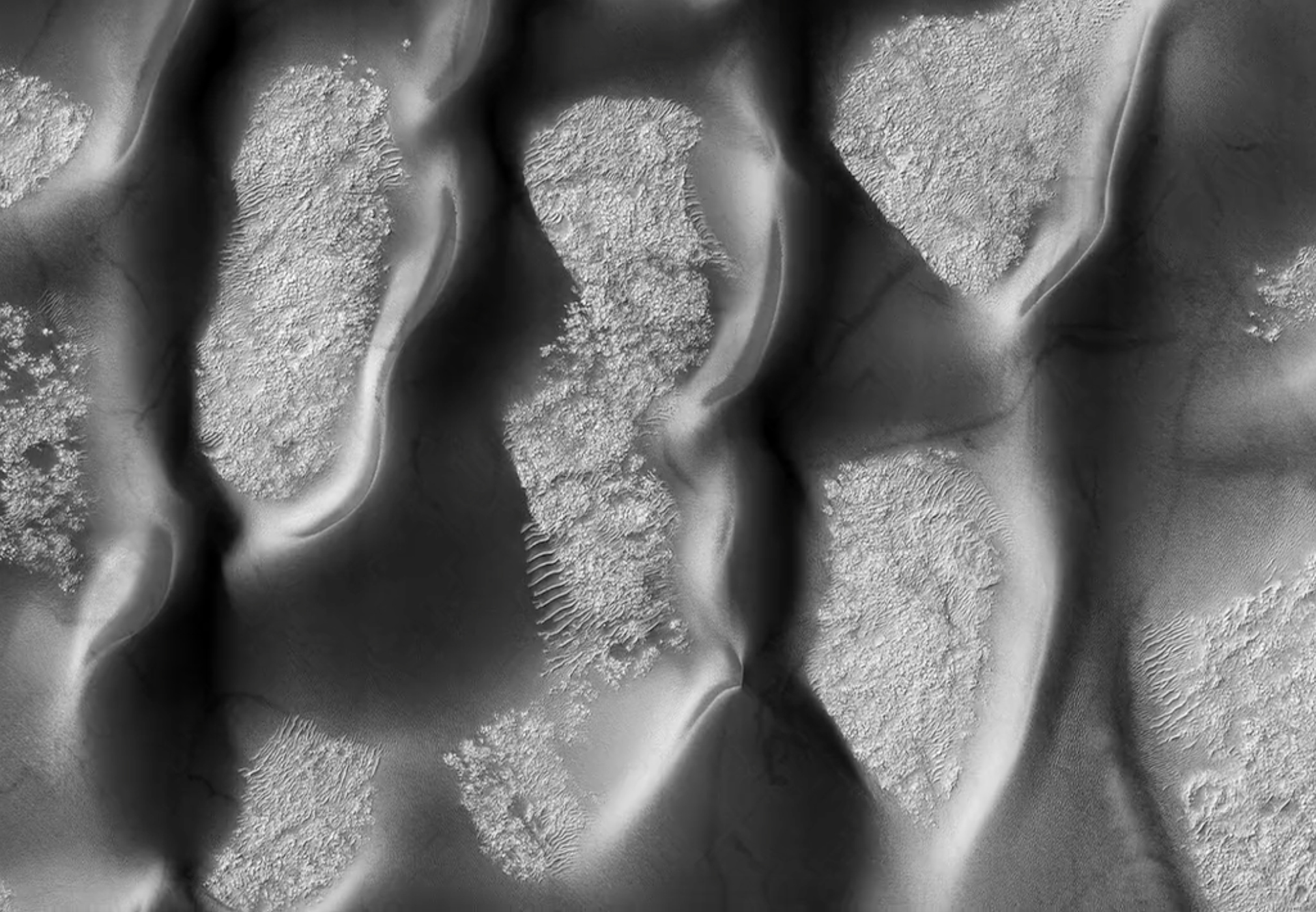
A conversation between Tessa Bolsover and Erin Elyse Burns
It’s a brisk winter evening – startlingly cold for Seattle. On a sidewalk in Capitol Hill, a group of people is huddled in front of an apartment building. There’s a quiet shuffle punctuating the crowd’s tempo – bodies shifting weight from one foot to the next, gently trying to ward off the chill. Just overhead are two windows filled with a video diptych that has a pace not unlike our own. Continuously moving over time, changing from image to image, and punctuated with evocative, fragmentary poetry. Tessa Bolsover’s Soon our bodies will be other buildings, on display at Vignettes’ Marquee exhibition series, calls upon environmental, molecular processes that evolve subtly. I have just returned to the Northwest after an intense stint in Nevada, saying goodbye to my mother, and feeling fairly certain I will not see her again. Grief is heavy on my mind. In Tessa’s project statement, she writes “In times of grief I turn to the idea of the body as a collection of materials. Our bodies exist for only a brief moment: a coincidence of molecules, soon to disseminate into countless other forms.” As I watch the video cycle through its patterned phases, I am struck by its lack of emotivity. A stick dragged across the snow. Deep sea divers swimming gracefully. Abstract macro imagery that looks like ice and snow through a microscope, yet I can’t help but see a pattern of human ears. Cells filmed through a microscope. A shadow falls upon a tree in birch forest. The camera enjoys the act of looking — the imagery inhabits real time. Through the lens of a biological perspective, I view beautiful imagery with a cool, scientific tone. I leave the night wondering if this is particular to me, or if Tessa has chosen an objective position as a strategy for the content of the work.
Erin Elyse Burns: The languorous imagery in Soon our bodies will be other buildings creates a certain calm that strikes me as reserved, almost without attachment. Will you speak to the emotional tone of your piece? Am I off in reading it as perhaps implementing the objectivity of a scientist?
Tessa Bolsover: I find a deep calm in the acknowledgement of the body as an entity within a large network. For me, observing becomes a kind of ritual to reintegrate with the strange and beautiful system of molecules of which my body is a part. I don’t see it as detachment as much as an attempt to empathize with the objectivity of the world beyond my ego.
Recently I’ve been reading a lot about the idea of Decreation (as re-defined in Anne Carson’s book of the same title), which basically means stripping away the self in order to get closer to the unknown (i.e. god). Observing the transience of materials is a way of stepping away from my mind and into my body, so to speak.
EEB: What lead you to utilize a looping imagery structure similar to the technique of phasing, as established by minimalist composers like Terry Riley and Steve Reich? Do you have a musical background?
TB: While working on this project I found the video editing process similar to the process of composing music. The concept of phasing had been floating around in my head for weeks, so utilizing an interpretation of the technique in my video looping process seemed like a natural fit. One of the main themes I was working with is the idea that molecules are constantly re-forming in various combinations, meaning that on a large scale, each object or entity can be reduced to a fleeting encounter between molecules, each following its own trajectory. Traditionally in phase music, two musicians simultaneously perform the same score at slightly different tempos, so that over time the relationship between the two players is realigned repeatedly, swaying between unison, echoing, and doubling. I wanted to extend this metaphor into my work by looping the two videos side by side at slightly different tempos so that the relationship between the two screens would change with each loop. Images and text fall in and out of unison periodically, putting the same emphasis on both order and disorder.
EEB: You work primarily in still photography – what has exploring the medium of video been like for you?
TB: I’m pretty new to making videos — it definitely had its share of challenges and opened up new ways of experimenting within time-based parameters, something I don’t usually get to do directly through my still photography.
EEB: You use both found footage and imagery you’ve captured – how do you approach this collage-like structure?
TB: Collage definitely feels like the right word for it. The footage I captured was a collection of gestures exploring the temporary physicality of my body within various landscapes. The rest of the imagery I collected through public domain archives online. Most of the videos I pulled from included little or no information on what the images were and why they were made — I found the combination of these sourceless videos and my own recordings an interesting juxtaposition and a way to contextualize the issue of interiority vs. exteriority.
EEB: Will you speak to the poetry you’ve written for this work?
TB: Writing is a huge part of my practice, although it rarely makes its way into my visual work. I wanted the text to feel like a collection of fragments, similar to the video segments. I was also thinking a lot about the way meaning is created through juxtaposition, and calling into question the extent to which we can read images like text and text like images.
soon our bodies will be other buildings excerpt, two channel video, 2017
Vignettes ‘Marquee’ installation excerpt / Seattle, Washington, February 2017
When Something Passes
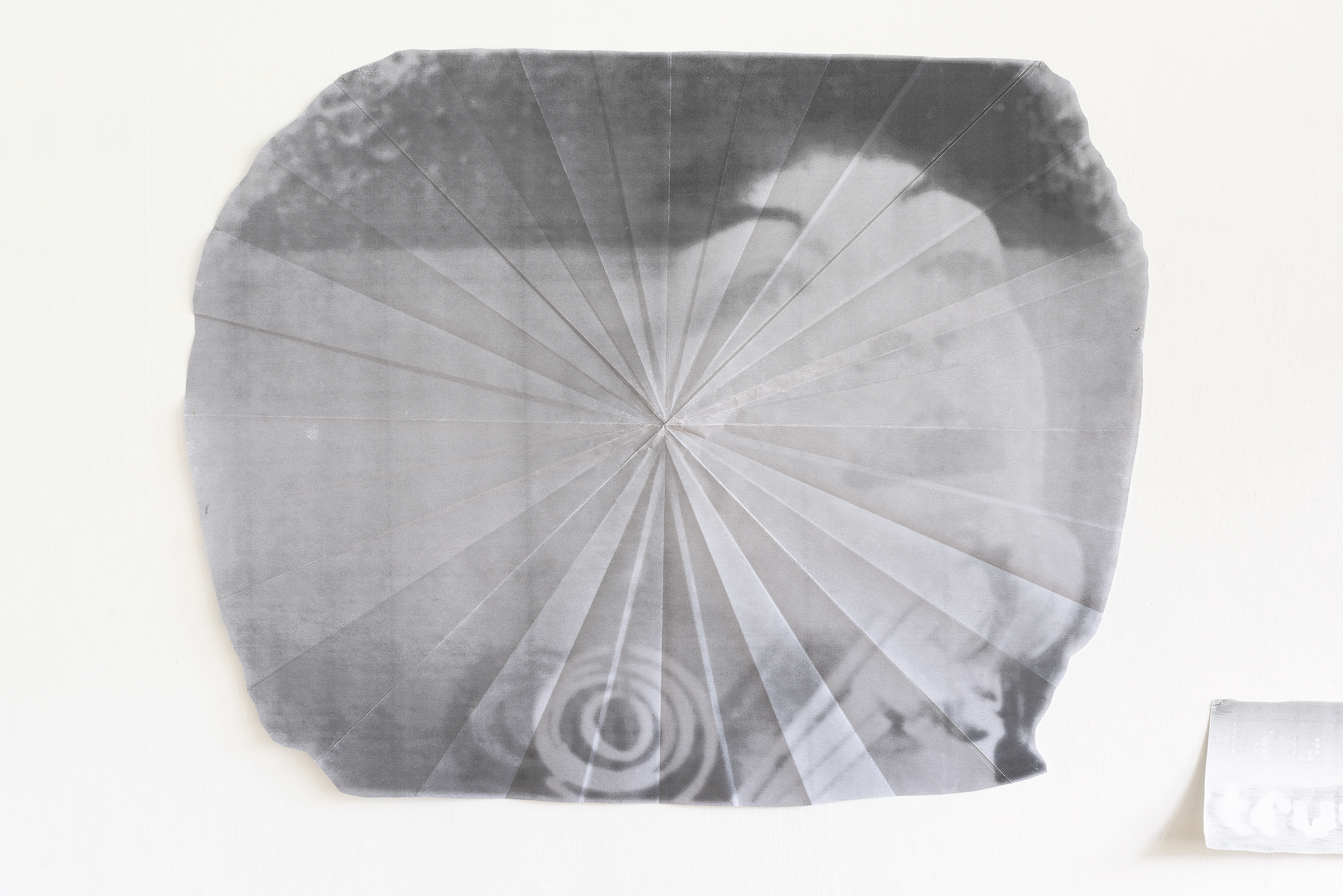
A conversation between Gretchen Frances Bennett & MKNZ
Derelict, you’re not coming back, I mean that in the nicest way, rest almost sounds like a bittersweet parting note to Vignettes as we know it. And we know it most intimately in Sierra Stinson’s one bedroom apartment on the 4th floor of El Capitan. The series of one-night shows in this space came to an end on the night of Gretchen Bennett’s opening.
We pack ourselves in the unit one last time, surrounded by the chirping of Bennett’s quiet drawings, xerox copies, and sentimental ephemera; all tacked sweetly to the walls, high and low, like little clues to a lush and secretive life. In the mix, there are faint portraits, including a large, faded xerox drawing of Angela Davis, with starburst creases, like something found and kept in the box of all your priceless notes from the past. In fact, the whole show feels that way; little treasures more important for them to be touched, moved around, repinned, carried in a pocket, to feel the full life of their influence. This feeling reverberates off the wall, when Gretchen reads aloud a poem that accompanies the show, breathing clues of their significance into the room.
In this moment, I am taken back to fall of 2004, to when Sierra and I (18 and 17 years old, respectively) were meeting for the first time in Gretchen’s Foundations class at Cornish College of the Arts. It was her first time teaching at the college, and it was our very first class. She would read passages from other artists, critics, scholars, and poets, to us in the mornings. With my head usually buzzing from the anxiety of living in a new city, I remember feeling soothed then, as I do now, 13 years later. I never would have thought that I would be interviewing her today about a show curated by Sierra. But Gretchen always held us as peers, rather than students, so perhaps this is her prophecy fulfilled; or perhaps we all stayed here, in part, to hold one another up; either way I’m grateful.
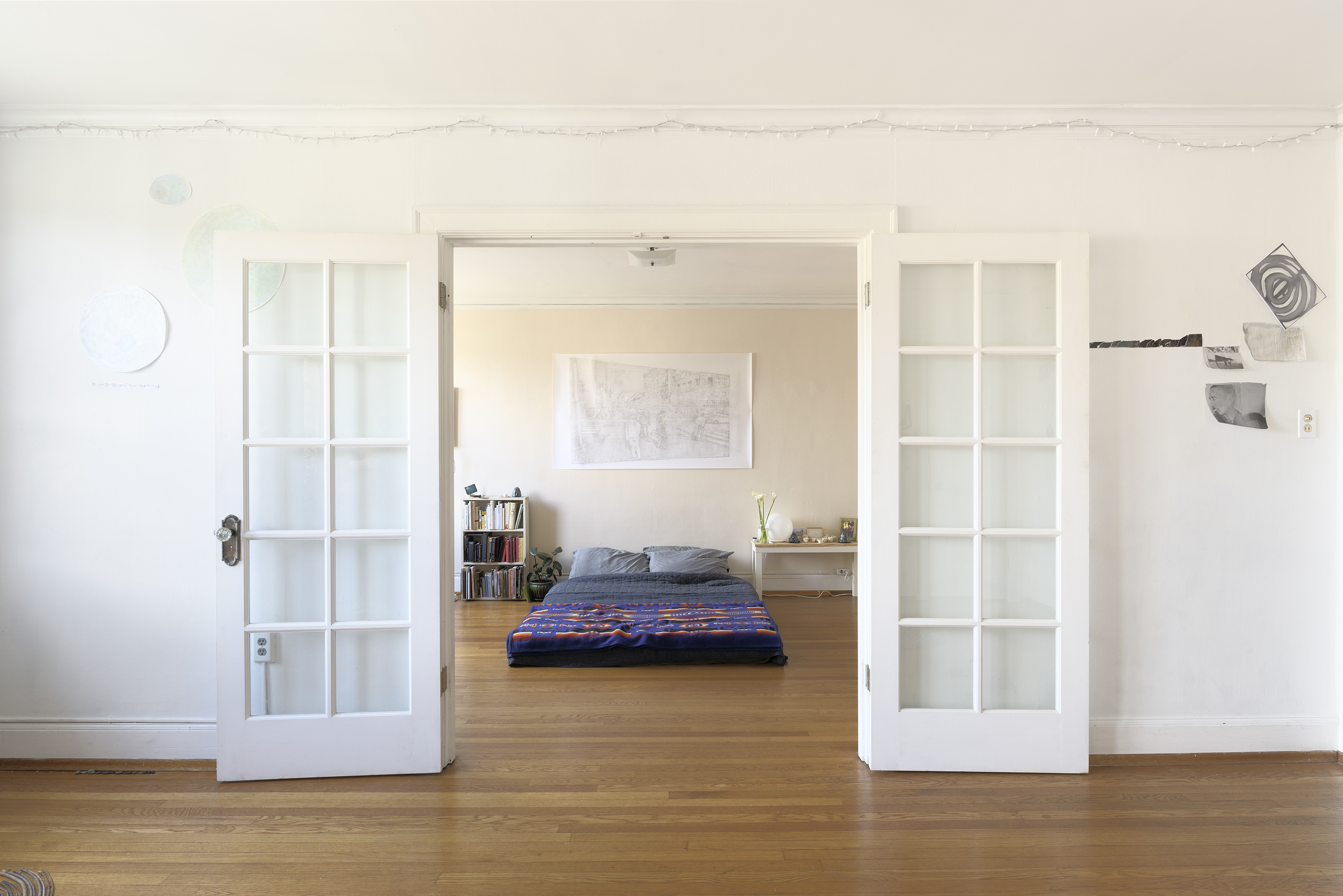
MKNZ: I love a good title and this show has a great title. Can you elaborate a little on the origin of this text?
Gretchen: So the title, “Derelict, you’re not coming back, I mean that in the nicest way, rest” is in haiku form. And as I understand haiku, it’s giving great credence to a moment; letting the every-day be holy. And I love that. I wanted to talk about my inability to make objects; to face my inability to make objects. And I guess that is because, when my parents passed away, the objects from their house that I had lived with were suddenly gone. And that makes sense, of course, but now I have empirical knowledge of it and it just stopped me for a while. So, in order to start making objects again, I had to talk about the ones that stay with me, the ones that are beloved. They give me courage. And those happened to be the objects that were closest to me in my studio.
While I was exhuming these objects, I was also asking them to go away forever, in a sense. The word “derelict” is also a word for the objects that you throw overboard a ship when it is listing and you don’t want it to sink. Unlike “jetsam”, “lagan”, or other maritime words used to describe objects thrown from a ship, “derelict” are the objects you have no hope to ever see again.
M: Do you think that in the process of bringing these objects into the light for other people to observe was a process of you letting them go?
G: Yes. Definitely. Sometimes literally when they are purchased and go away. And it’s also letting go in a way that’s equivalent to acceptance. Things were kind of falling apart, disintegrating, and, with the promise of reforming later, I had to let them drift.
I was letting go of expectations as well. I was letting go of my persona as an artist. I actually think maybe I don’t have that persona anymore… yeah, I let that go.
M: That’s scary.
G: Yes. It doesn’t mean I don’t perform that persona sometimes, but when I’m performing it’s so my voice can come in louder, literally. It feels different. It feels like I’m being more myself in that moment. So yeah, the show is letting go of some things and claiming others. Maybe these objects are a threshold.
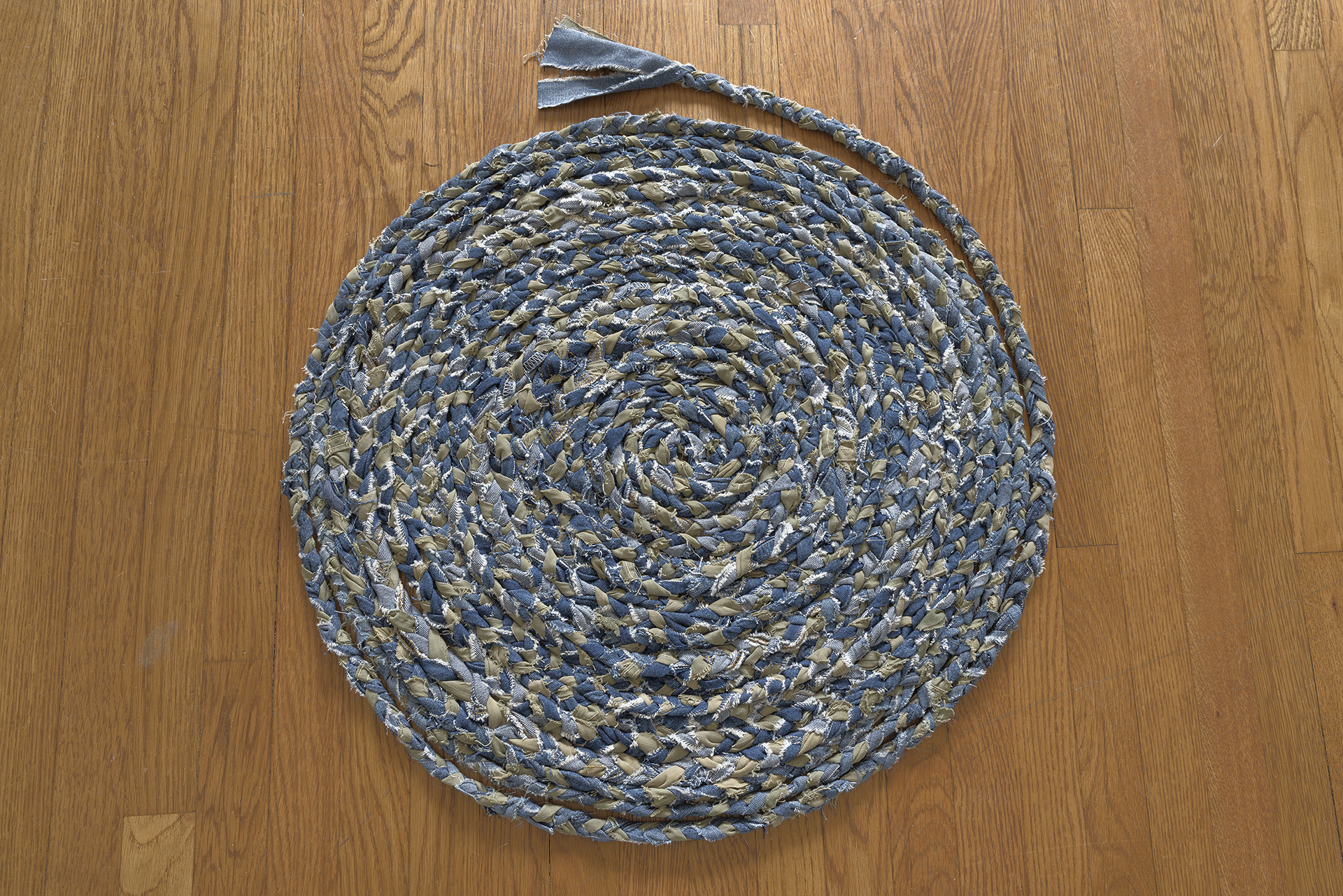
“Another Very Small Universe,” rag rug made from braided repurposed clothing from the artist and her father.
M: I think sometimes we can imbue objects with a lot of meaning when we are alone with them for a long time. Sometimes letting other people see them that does this thing where it takes the air out of them a little bit. I can become so superstitious about an object, to the point where it becomes really one-dimensional. And maybe letting it out into the world can allow other people to put their own projections onto it, which makes it a little less your own, but maybe less scary.
G: Yes. When someone recognizes something to the point of wanting to take it home, it’s such a relief to me.
M: There is a lack of preciousness to the way you chose to exhibit these drawings. They are so delicate and fragile, but also folded, crinkled, or fingerprinted in places. This give them a feeling of age, of temporality.
G: It’s interesting, right away sometimes I say that I don’t like something, that I don’t want something, and it’s a build up to wanting it or liking it. Today in the studio on my List Of Problems, I wrote, “I’m not creating drawings to comment on the act of drawing, sorry”. Both laugh. I was looking at how the photocopier draws and I wanted to collaborate with that machine, and I really became attached to the aesthetic of those shifting greys and the way they slide across the paper. I would draw in response to that relationship for a lot of the pieces. And I guess that is commentary on What Is Drawing.
I think the folding, too – I had this brief conversation with Tim Cross about how a photocopy can be a real material, and that’s how you keep those objects, by folding them. And the folds on the Angela Davis piece are this radiating starburst shape, I like that. I have this feeling that archiving is futile. Maybe that’s an adolescent thought.
M: I think that’s the mature thought. The way that you’re talking about treating these drawings sounds like performance to me. You have to let go of the idea of archiving things to make a really present performance. And they sort of share that quality. You can tell that they have a lifespan, you can tell that they are going to whither away. I feel that there is something undervalued about storytelling; sharing the idea or memory of something rather than the physical thing. That’s when you start to build mythology, you know? When something passes.
G: Oh that’s nice, I love that, “when something passes”. And passes is the perfect language for this body of work. Its an intersection for many meanings. I want to keep thinking about what archival is when I use that word.
There are artists I was paying homage to, like Vija Celmins repeating the rocks as an action of devotion. Mine were very off-hand, or deliberate to seem off-hand. And then I was thinking of Morandi, whose objects are always just coming into the light. Those all feel like they fit into the idea of the temporary. If I bring them into my studio practice, I’m letting them live even more. That’s an action of wanting something to last.
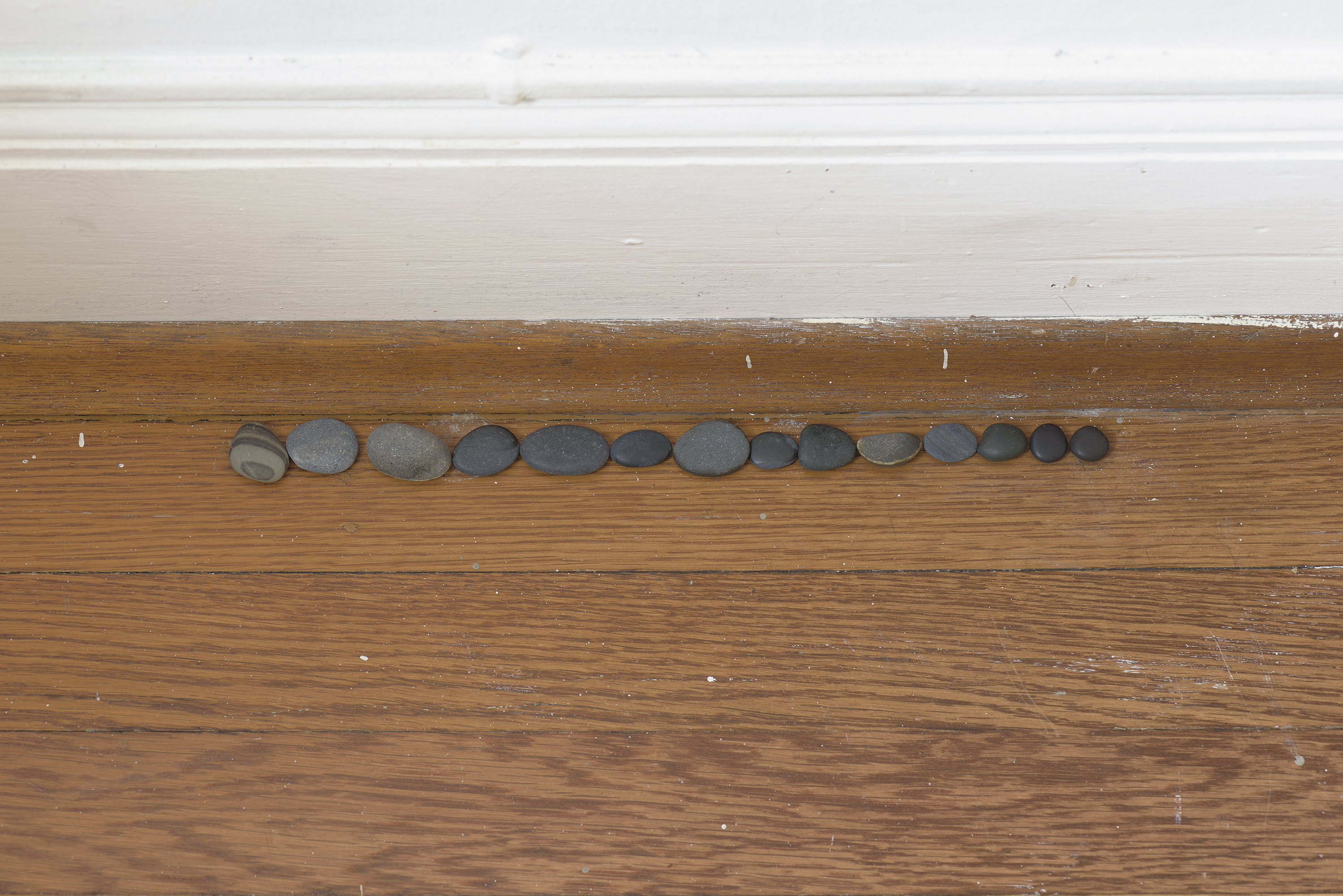
“Ruby Beach Honeymoon Rocks” Found stones. 14″ W.
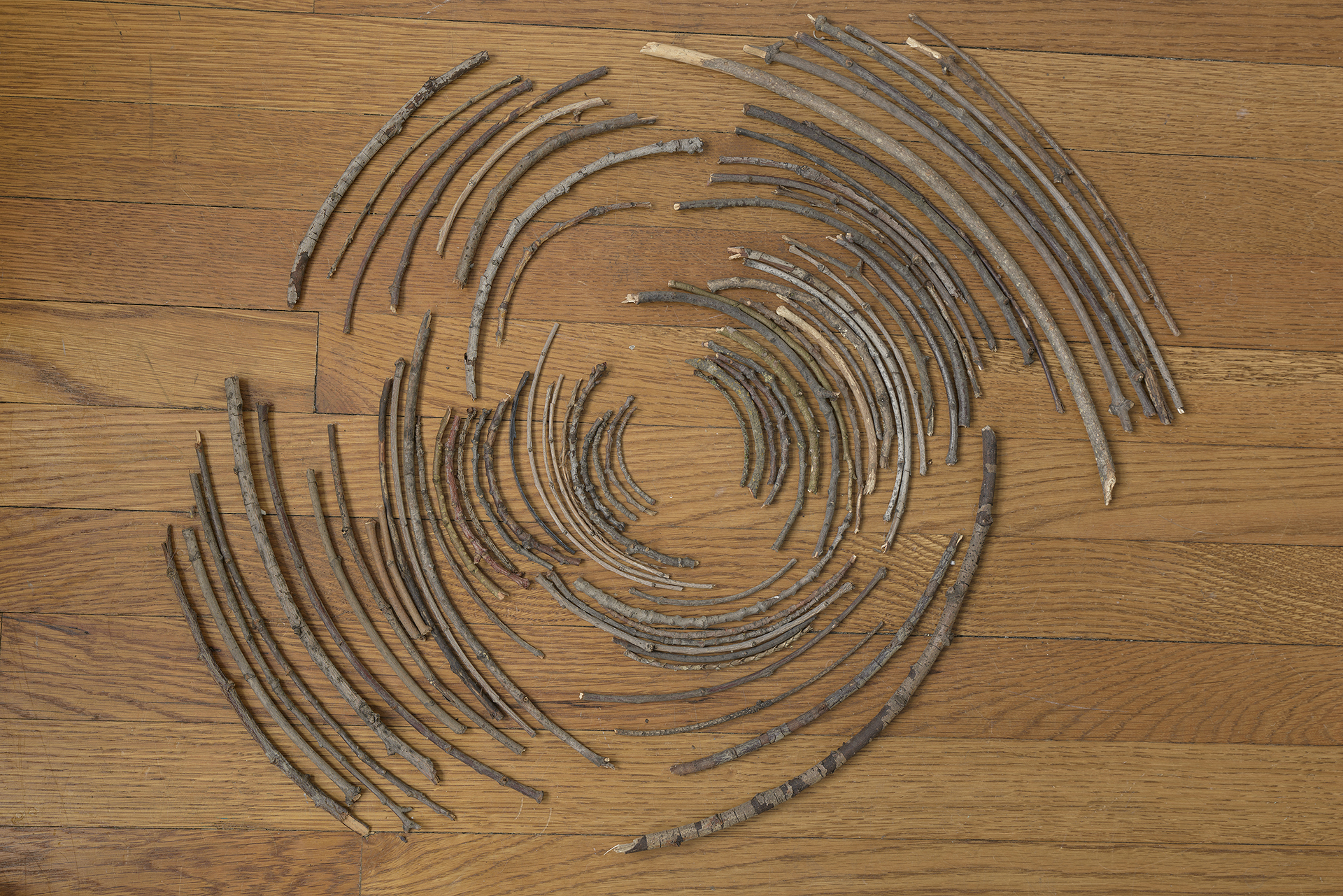
“Ripple Effect.” gathered unaltered, arranged sticks from PNW tree varieties. 24″ W.
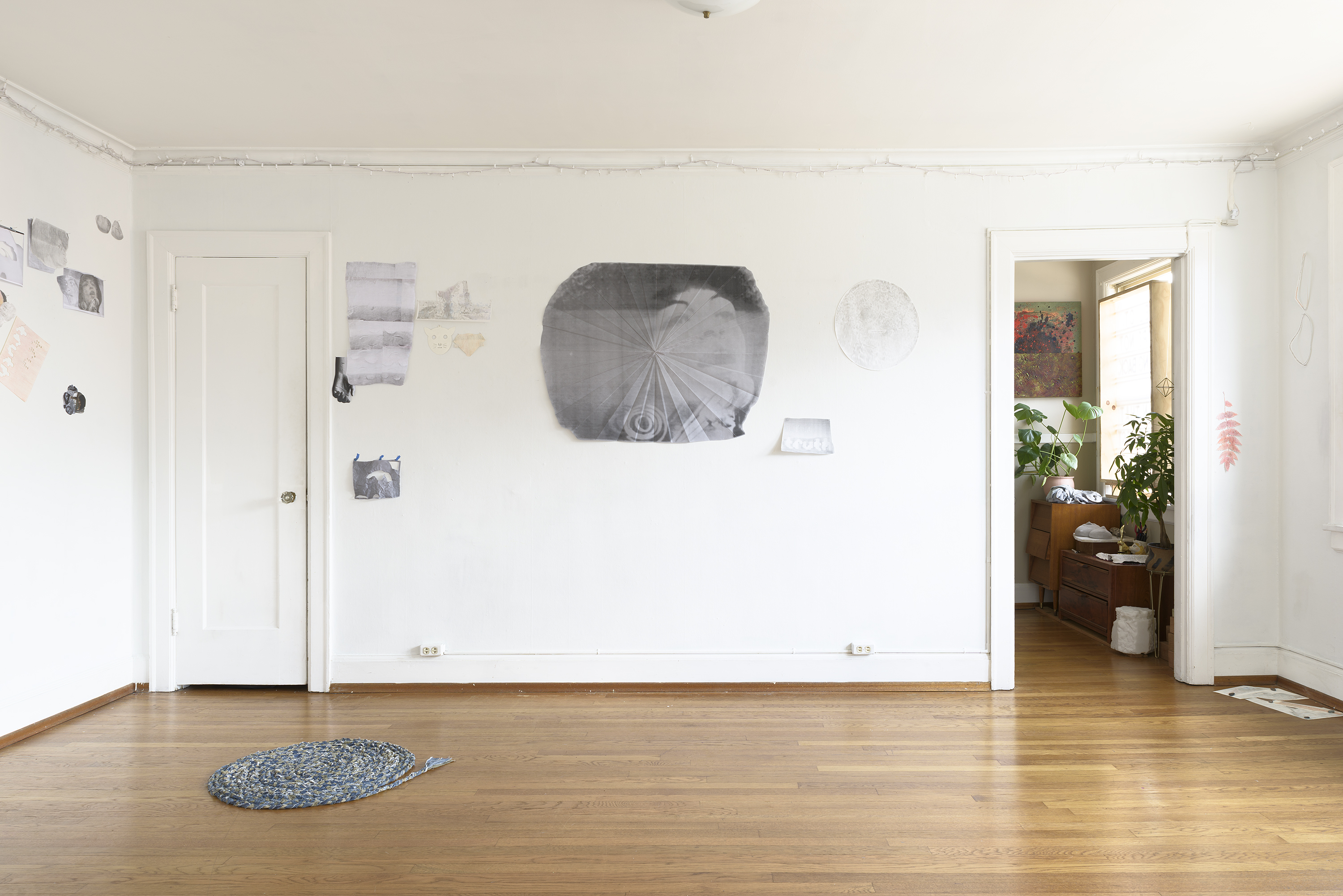
M: In your footnotes, you state “The Angela Davis drawing holds the room, just as it’s been a ballast in my studio. Many of these works are created between the photocopy and I, both of us drawing”. This is a very beautiful and relatable sentiment to me. And feels even more powerful, when standing in the room anchored by the starburst folded Angela Davis drawing, and immediately across the room is the giant, “Vesna is Spring, Venus is Venus” of you as a child, sheepishly front and center in an urban Slovakian landscape. What is the dialogue between the two pieces?
G: It started out as a historical fact and alignment of events. I started thinking about a childhood trip that happened in 1972 when I went to Eastern Europe with my family. And I started remembering that I was greatly affected by certain world events, even though not directly. Angela Davis is one of those events, along with the build up to Watergate, the Vietnam war. In that year Angela Davis was freed from jail and taken off Nixon’s most wanted list. And I saw her in the context of European publications, where her image was the only thing legible to me. So that’s where it started. And also because her image is so relevant, but her image and her person are two different things. And, how humbly for me, I have to understand that she’s walking among us. So she’s opposite this photo drawing of me when I was 12, while my self image was just forming. This was when I was forming my cultural and creative sensibilities.
M: Your poem, “A blue that keeps moving” accompanies this show. It chronicles the day you broke your knee at the beach, and the spreading of your parents’ ashes. I am reminded of Maggie Carson Romano’s show at Glassbox, with her text recalling her accident in the ocean, and the quiet pieces of her show holding a tremendous gravity as evidence to her survival and recovery after the fact. Do the pieces of this show serve as a kind of “evidence” for you?
G: I think it’s interesting to think of it alongside Maggie’s show. A lot of those choices on my part were intuitive and I just trusted that they were poetic both with the objects and with the words; in that way that poetic space is elastic. I think heavy stories sometimes need to be talked about lightly, so that you can talk about them at all…and talk about many things that you might not know you need to talk about. So I approached it in a more meandering way and ended up presenting a constellation of objects up against really substantial words.
So I would say that yes these objects are evidence for me, but that they needed to be light.
Like talking about the weather, when I really mean my knee.
M: It reminds me of the feeling of existing in the reverb of something traumatic happening. You can fixate on something to ease your mind, which makes everything sort of dilate. When my mind is happy I’m not noticing every little thing. But then in the aftermath of a traumatic event, I can obsess over an object, and it could be anything, and then it becomes precious.
G: The object becomes a place for memory to reside.
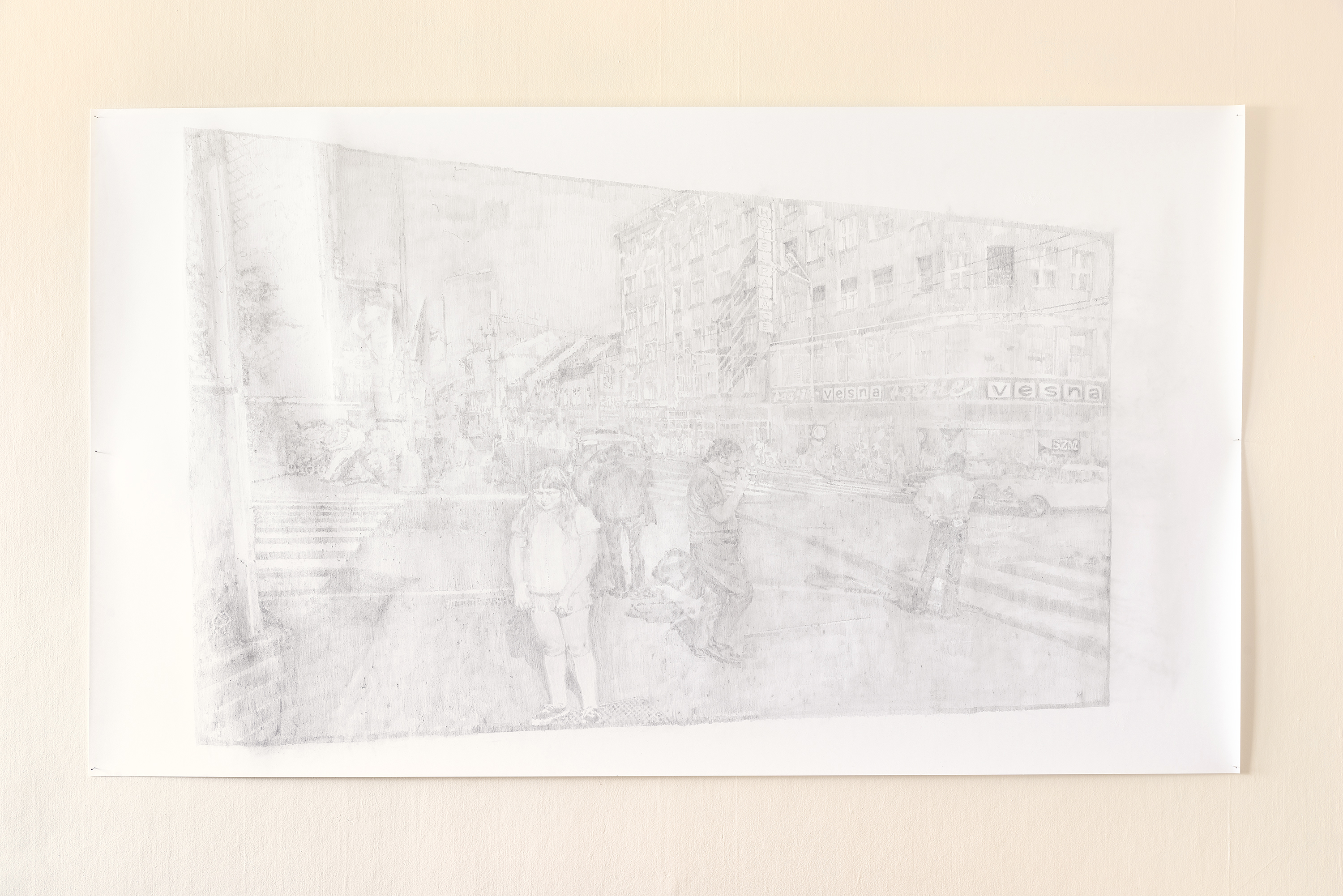
Graphite pencil drawing on Japanese screen paper. 38″H X 72″ W. “Vesna is Spring, Venus is Venus,” a self-portrait, drawn from a 35mm slide of the artist as a 12-year-old on a seminal trip to live in Czechoslovakia.
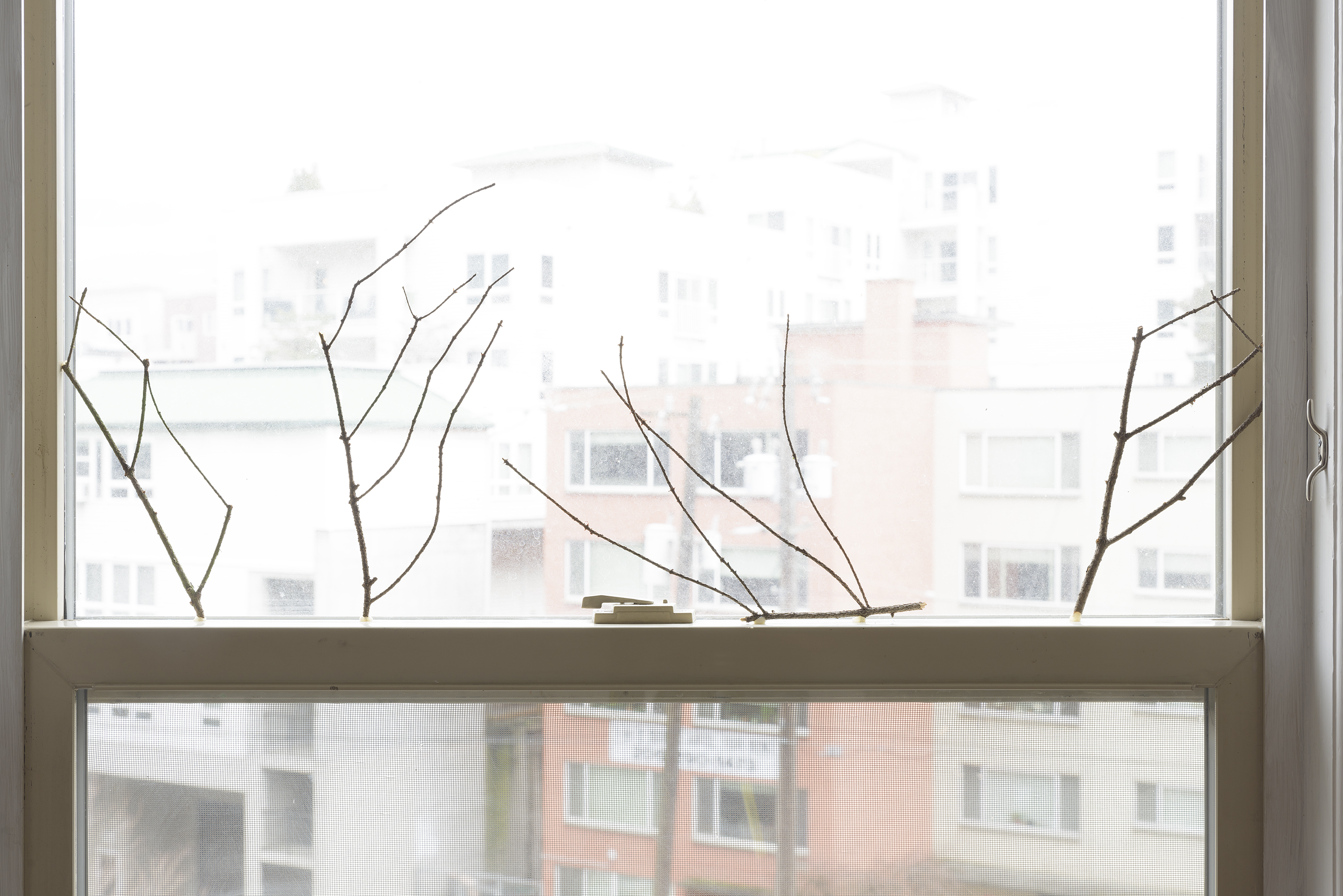
“Windfall Alphabet (extra-lingual version),” which appropriates found fallen twig materials, in this case an extra-lingual fir font, into a human lexicon: from the order of the tree to the order of language, letters, sentence and sign.
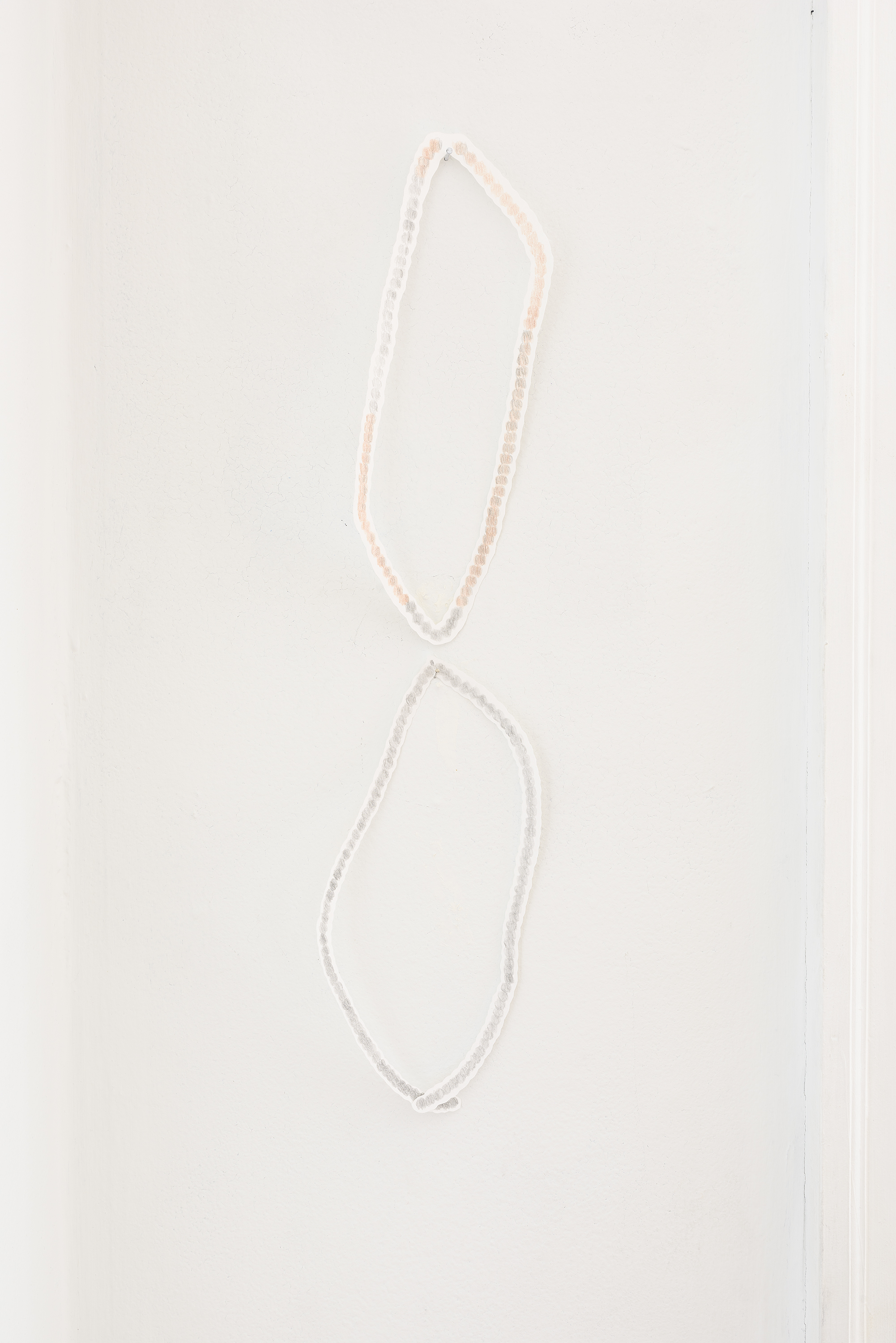
“Garland” Color pencil drawing on hand-cut paper, tracing objects on the frontier of existence. 16″ H.
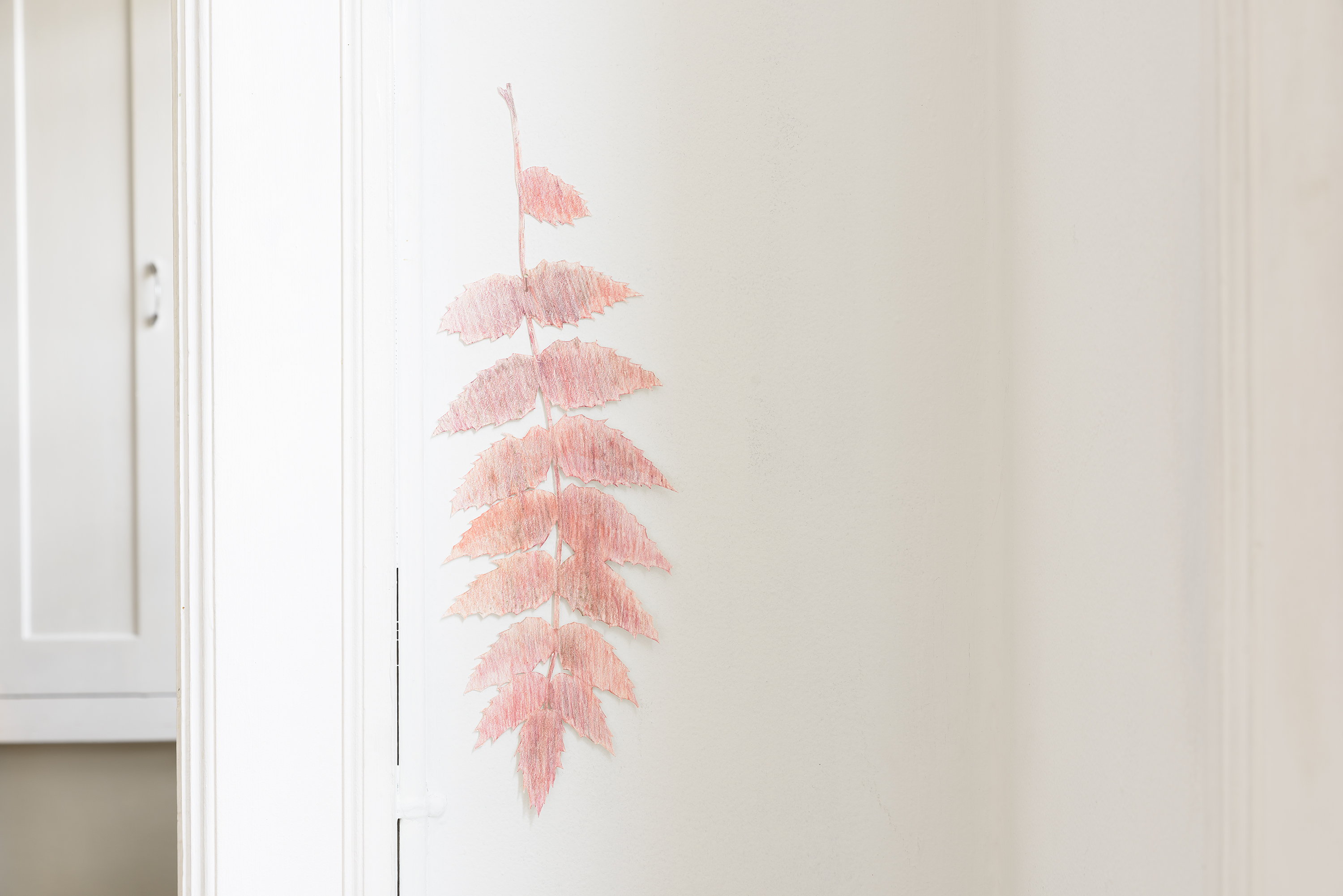
“Oregon Grape” Color pencil drawing on hand-cut paper, tracing objects on the frontier of existence. 14″ H.
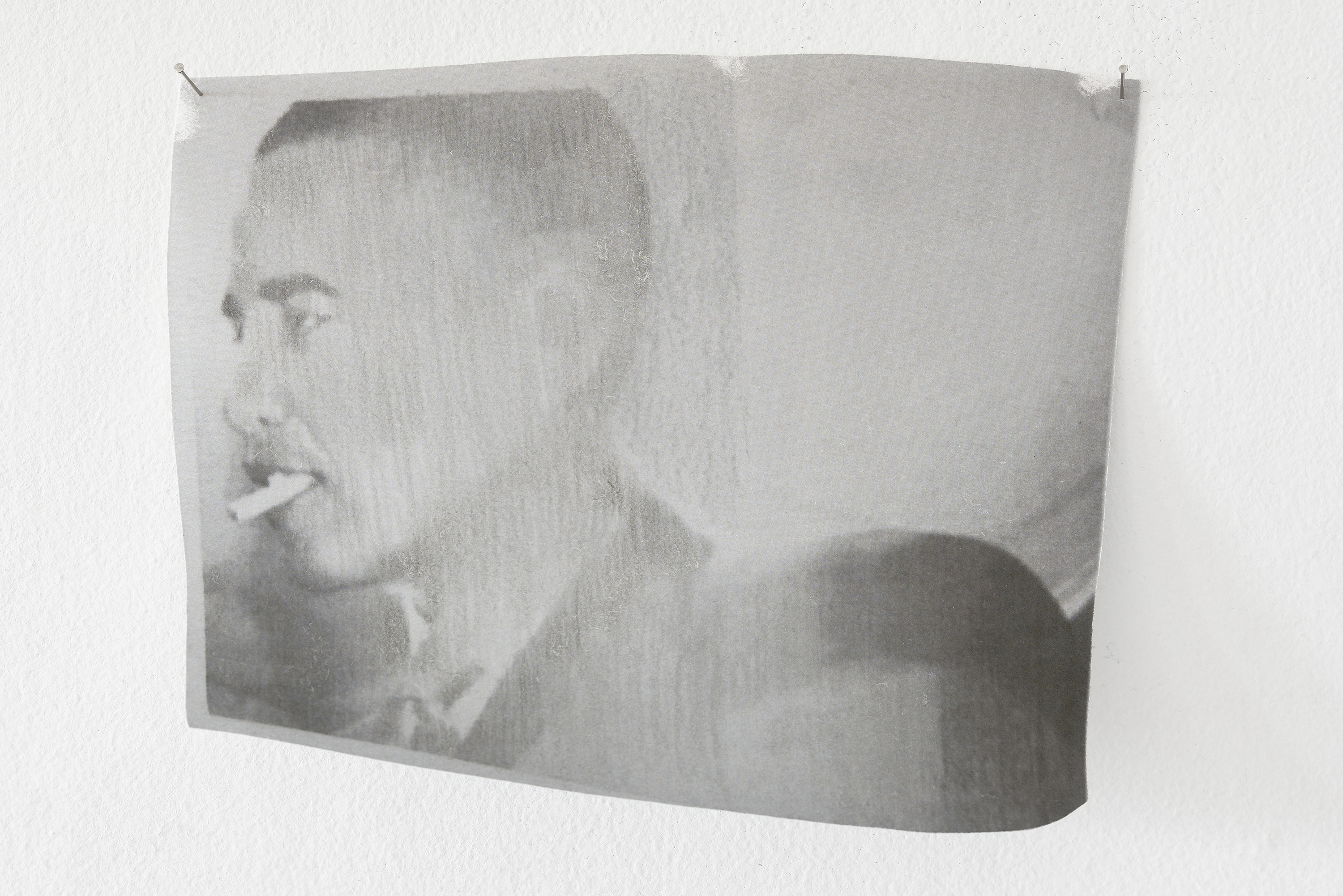
Photocopy and color pencil drawings on paper, tracing objects on the frontier of existence. 11″ W. “Obama, Smoking.”
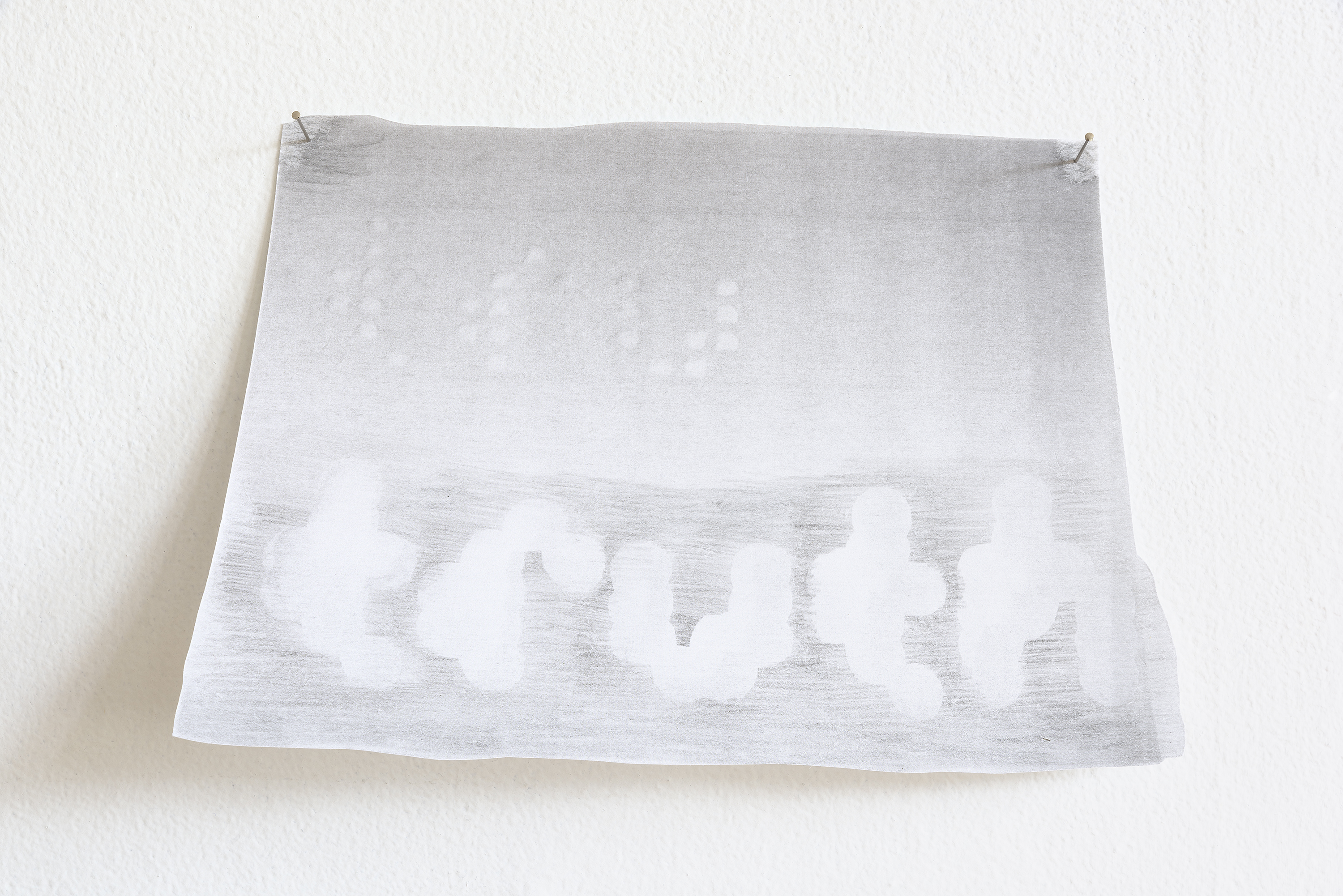
“tru truth” Photocopy and color pencil drawings on paper, tracing objects on the frontier of existence. 11″ W.
